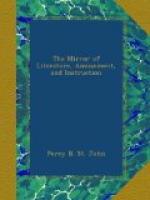North.—God bless you, my dearest James! shake hands.
* * * * *
SPIRIT OF DISCOVERY
* * * * *
POPULAR PHILOSOPHY.
Dr. Arnott’s Elements of Physics.
Vol. ii. Part I.
We are warm friends to the diffusion of knowledge, and accordingly receive the present portion of Dr. Arnott’s work with much satisfaction. We believe the sale of the first volume to have been almost unprecedentedly rapid, (a fourth edition being called for within two years) in comparison with the usual slow sale of scientific works. This success may easily be traced. The title of the work is not extraordinarily inviting, illustration, not embellishment, is attempted in a few outline diagrams, and the only external inducement to read, is a plain, legible type, to suit all sights. Looking further, we find the great cause in the manner as well as the matter of the volume, which is throughout a text-book of plain-spoken philosophy, or as the author says in his title-page, “independently of technical mathematics.” Again, in his introductory chapter on “Imponderable Substances,” he says, “To understand the subjects as far as men yet usefully understand them, and sufficiently for a vast number of most useful purposes, it is only necessary to classify important phenomena, so that their nature and resemblances may be clearly perceived.” The main error of most people who write on philosophical subjects, or the stumbling-block of all students, has been that of the writer presuming too much upon the cultivated understanding of his reader. Thus, in the midst of very familiar explanations we have often seen technicalities which must operate as a wet blanket on the enthusiasm of the reader; and break up the charm which the subject had hitherto created. Upon this principle, treatise upon treatise has been published without effecting the primary object. The matter of Dr. Arnott’s work, however, appears to us to be in strict accordance with its title—elementary; but it is accompanied with a variety of explanations of familiar facts on philosophical principles, which possess attractions of a most amusive character.
The present portion of Dr. Arnott’s work comprehends the subjects of Light and Heat, which admit of more familiar illustration than any other branches of Natural Philosophy. Of this advantage the author has fully availed himself in a variety of familiar exemplars, which, to speak seriously are brought home to our very firesides. A few of these facts will form a recreative page or two for another MIRROR: in the meantime we quote a few illustrative observations on the most interesting exhibitions of the day:—




